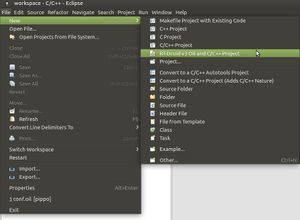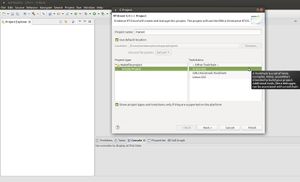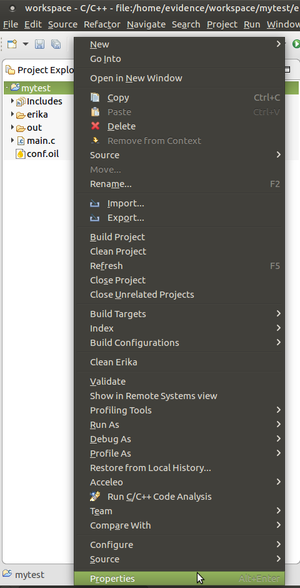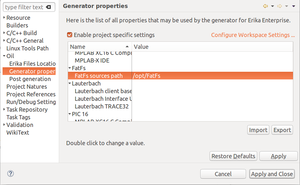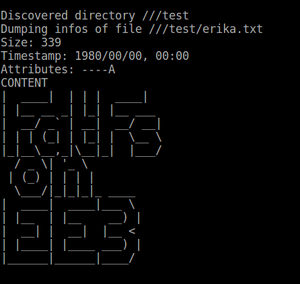FatFS
Contents
Introduction
FatFs is a tiny library which provides FAT/exFAT support for small embedded systems.
The stack support will be provided starting from GH63 release of Erika with a memory driver which basically exports a portion of memory as a block device. The memory which file system is built upon can be private in Erika or shared between Erika and other guests (e.g. Linux).
The following sections describe how to use use a subset of basic functionalities of FatFs.
FatFs features
As described in the FatFs's main web page, this library offers the following features:
- DOS/Windows compatible FAT/exFAT filesystem
- Long file name in ANSI/OEM or Unicode
- exFAT filesystem
- Thread safe for RTOS
- Multiple volumes (physical drives and partitions)
- Variable sector size
File system functionalities are separated from the disk I/O layer. This page lists all the available FatFs functionalities which can be enabled/disabled.
Erika/FatFS demo on Jetson TX2 with Jailhouse Hypervisor (aarch64)
This demo shows how to handle directories/files on a FAT file system on Erika Enterpries v3 running as a Jailhouse inmate on Jetson TX2 board:
- Download the FatFs library as archive from the Download section on http://elm-chan.org/fsw/ff/00index_e.html or simply clone the Git reposity from https://github.com/RIOT-OS/FatFS.git
- In the FatFs downloaded sources enable the Long Filename Support and the Mkfs function as follows.
In/full/path/FatFS/source/ffconf.h:
- enable
#define FF_USE_LFN 1 - enable
#define FF_USE_MKFS 1.
- enable
- Set the build environment as described in Nvidia Jetson TX1 and TX2 (cross-toolchain, Jetson platform setup, Jailhouse cross-compiling)
- Run the RT-Druid tool
- Create a new project by clicking on
New→RT-Druid v3 Oil and C/C++ Projectas shown in the next Figure: - Name the new project (e.g.,
mytest) and select the Cross-GCC as shown in the next Figure: - Import a
main.cand aconf.oilfrom an existing template by checking the boxCreate a project using one of these templatesand selectingaarch64→Jailhouse→FatFs→FatFs usage on memoryas shown in the next Figure: - Right click the project and select
Propertiesas shown in the following Figure: - Click
Oil→Generator properties, enable project specific settings and specify the directory containing the FatFs library for ERIKA3: - Configure the RT-Druid as described in Nvidia Jetson TX1 and TX2#RT-Druid set-up
Creating a private FAT file system on Erika
In order to create a private FAT file system on Erika, the #define EE_MEM_LOCAL must be enabled in main.c provided by the RT-Druid template (described above), Erika will perform such actions:
- Before starting OS, will:
- inizialize the
fmemdriver - create a FAT file system on an array located in
.datasection of the executable - create the directory
test - create the file
erika.txtin the directorytest
- inizialize the
- The
Task1will dump the directories and files content ( output should look like this):
Sharing a FAT file system with Linux
In order to share a FAT file system with Linux, the #define EE_MEM_LOCAL must be disabled in main.c.
Erika expects to find a valid FAT file system at a given address location.
This address represents the start of a physical shared memory region between Erika and Linux where the latter must provide a valid file system (see next subsections).
After proper fmem initialization with the shared memory address, Erika will perform the same actions of directory/file creation described in the previous example.
Please note that the memory region is mapped into the inmate address space through the map_range function.
Setup of the Jailhouse environment
Jailhouse should be aware of this shared region. This is achieved by putting in both the root cell and inmate cell the following section:
{
.phys_start = 0x274800000,
.virt_start = 0x274800000,
.size = 0x80000,
.flags = JAILHOUSE_MEM_READ | JAILHOUSE_MEM_WRITE
| JAILHOUSE_MEM_ROOTSHARED,
},
where 0x274800000 is the physical start address of the shared region (given by the flag JAILHOUSE_MEM_ROOTSHARED).
Thus Erika expects the memory macro to be initialized with such value (e.g. #define memory (const void*)(0x274800000)).
Furthermore the executable size (including the FatFs library) could not fit the default RAM size assigned to the inmate by default. This implies the following changes to be applied to your Jailhouse working copy cloned from https://github.com/evidence/linux-jailhouse-jetson.git:
- in
configs/arm64/jetson-tx2.c:- increase memregions numbers:
- struct jailhouse_memory mem_regions[66]; + struct jailhouse_memory mem_regions[67];
- add the shared memory at the end of listed memregions as described above
- in
configs/arm64/jetson-tx-demo.c:- increase memregions numbers:
- struct jailhouse_memory mem_regions[5]; + struct jailhouse_memory mem_regions[6];
- increase inmate's RAM size:
- add the shared memory at the end of listed memregions as described above
- in
inmates/lib/arm-common/mem.c:- increase inmate's RAM mapping:
void arch_mmu_enable(void) { unsigned long mair, sctlr; - map_range((void*)CONFIG_INMATE_BASE, 0x10000, MAP_CACHED); + map_range((void*)CONFIG_INMATE_BASE, 0x100000, MAP_CACHED); map_range((void*)COMM_REGION_BASE, PAGE_SIZE, MAP_CACHED);
/* RAM */ {
.phys_start = 0x270000000,
.virt_start = 0,
- .size = 0x10000,
+ .size = 0x100000,
.flags = JAILHOUSE_MEM_READ | JAILHOUSE_MEM_WRITE |
JAILHOUSE_MEM_EXECUTE | JAILHOUSE_MEM_LOADABLE,
FatFs on Linux side
Linux can provide a file system to Erika with the help of the FatFs library which can be built for Linux as well. To build the library for Linux just use the following commands:
:~ mkdir fatfs-linux-build
:~ aarch64-linux-gnu-gcc -DFATFS_LINUX -I /full/erika3/path/contrib/fatfs/diskio/memory/ -I /full/FatFs/path/source/
-c /full/erika3/path/contrib/fatfs/diskio/memory/*.c
/full/FatFs/path/source/ff.c /full/FatFs/path/source/ffsystem.c
/full/FatFs/path/source/ffunicode.c
:~ aarch64-linux-gnu-ar rcs libfatfs.a *.o
Now that library is built, you can edit a main.c which looks similar to the one provided with the FatFs Erika demo. FatFs functions are the same indeed (except for the handling of system time which is correctly taken from Linux time). The main difference with the Erika application is in the shared memory's mapping which is performed with mmap in order to be accessed by the application. A code snippet which performs such mapping could be the following:
long int physical_address = 0x274800000;
size_t memory_size = MINIMUM_FAT_SIZE;
void *process_memory_address = NULL;
int fd = open("/dev/mem", O_RDWR);
if(fd >= 0 && physical_address && size){
process_memory_address = mmap(NULL, memory_size, PROT_READ|PROT_WRITE, MAP_SHARED, fd,
physical_address);
}
After calling this function with proper parameters, the application must init the fmem drive with f_mem_init(process_memory_address, memory_size) and then create/modify the FAT file system (use f_mkfs, f_mount and friends...).
Link your main with the library:
:~ aarch64-linux-gnu-gcc -I /full/erika3/path/contrib/fatfs/diskio/memory/ -I /full/FatFs/path/source/
-c main.c -L/full/path/fatfs-linux-build -lfatfs
First execute the Linux application and then the Erika inmate. The latter will show all the directories/files you decided to create.
